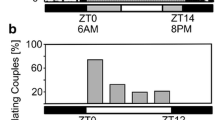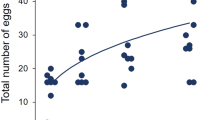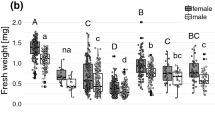Abstract
As a fly tracking the availability of fruits along climatic gradients, Drosophila suzukii is deemed to be rather flexible in relation to environmental factors, among which temperature is a major player. We sampled potential wild host fruits of D. suzukii along two elevational gradients in mountain areas of north-eastern Italy, in order to measure fly performance in relation to temperature. In addition, we used a strong natural temperature gradient in an open-top cave, covering the lower range of temperatures known for D. suzukii, to deploy laboratory stock colonies to mimic conditions existing along elevational gradients. At least nine wild host species yielded adults of D. suzukii in the mountain area (Daphne mezereum, Lonicera alpigena, Lonicera caerulea, Lonicera nigra, Lonicera xylosteum, Rubus caesius, Rubus saxatilis, Sambucus nigra, and Sambucus racemosa) when the daily average temperature in the three preceding weeks was at least 11.1 °C. Similar results were obtained with the laboratory colonies reared on an artificial medium in the cave, where oviposition and development from egg to adult occurred at above 11.6 °C. Both values are lower than previously recorded lower thresholds for development at both constant and fluctuating temperatures. These findings indicate that D. suzukii performs well at low temperatures, suggesting that population buildup may occur even under these conditions, with likely consequences on crops and wild host reproduction.



Similar content being viewed by others
References
Agenzia Regionale per la Prevenzione e Protezione Ambientale del Veneto (ARPAV) (2014) http://www.arpa.veneto.it/temi-ambientali/meteo/riferimenti/documenti/documenti-meteo/20140905_ESTATE%202014.pdf/at_download/file. Accessed 07 Dec 2014
Angilletta MJ Jr (2009) Thermal adaptation: a theoretical and empirical synthesis. Oxford University Press, Oxford
Asplen MK, Anfora G, Biondi A et al (2015) Invasion biology of spotted wing Drosophila (Drosophila suzukii): a global perspective and future priorities. J Pest Sci 88:469–494
Battisti A (1994) Voltinism and diapause in the spruce web-spinning sawfly Cephalcia arvensis. Entomol Exp Appl 70:105–113
Battisti A (2008) Forests and climate change: lessons from insects. iFor Biogeosci For 1:1–5
Battisti A, Cescatti A (1994) Temperature-dependent growth model for eggs and larvae of Cephalcia arvensis (Hymenoptera: Pamphiliidae). Environ Entomol 23:805–811
Battisti A, Larsson S (2015) Climate change and insect pest distribution range. In: Bjorkman C, Niemela P (eds) Climate change and insect pests. CABI International, Wallingford, pp 1–15
Benetti A, Cristoferi W (1968) Il Covolo di Camposilvano nei Lessini veronesi. Studi Trentini Scienze Naturali 45:284–305 in Italian, English abstract
Chown SL, Nicholson SW (2004) Insect physiological ecology. Mechanisms and patterns. Oxford University Press, Oxford
Cini A, Anfora G, Escudero-Colomar LA et al (2014) Tracking the invasion of the alien fruit pest Drosophila suzukii in Europe. J Pest Sci 87:559–566
Doucet D, Walker VK, Qin W (2009) The bugs that came in from the cold: molecular adaptations to low temperatures in insects. Cell Mol Life Sci 66:1404–1418
Field CB, Barros VR, Mach KJ et al (2014) Technical Summary. In: Climate change 2014: impacts, adaptation, and vulnerability. Part A: global and sectoral aspects. Contribution of working group II to the fifth assessment report of the intergovernmental panel on climate change Cambridge University Press, Cambridge, United Kingdom and New York, pp 35–94
Gobiet A, Kotlarski S, Beniston M et al (2014) 21st century climate change in the European Alps: a review. Sci Total Environ 493:1138–1151
Grassi A, Giongo L, Palmieri L (2011) Drosophila (Sophophora) suzukii (Matsumura), new pest of soft fruits in Trentino (North-Italy) and in Europe. IOBC/WPRS Bull 70:121–128
Grassi A, Anfora G, Maistri S et al (2015) Development and efficacy of Droskidrink, a food bait for trapping Drosophila suzukii. IOBC WPRS Bull 109:197–204
Indiana University (2014) Bloomington Drosophila Stock Center http://flystocks.bio.indiana.edu/Fly_Work/media-recipes/bloomfood.htm. Accessed 25 Mar 2014
Ioriatti C, Boselli M, Caruso S (2015) Approccio integrato per la difesa dalla Drosophila suzukii. Frutticoltura 4:32–36 in Italian, English abstract
Jakobs R, Gariepy T, Sinclair B (2015) Adult plasticity of cold tolerance in a continental-temperate population of Drosophila suzukii. J Insect Physiol 79:1–9
Kanzawa T (1939) Studies on Drosophila suzukii Mats. Kofu. Yamanashi Agricultural Experimental Station, Yamanashi, pp 1–49 (in Japanese, translated by Shinji Kawai)
Kimura MT (2004) Cold and heat tolerance of drosophilid flies with reference to their latitudinal distributions. Oecologia 140:442–449
Kinjo H, Kunimi Y, Nakai M (2014) Effects of temperature on the reproduction and development of Drosophila suzukii (Diptera: Drosophilidae). Appl Entomol Zool 49:297–304
Lee JC, Dreves AJ, Cave AM et al (2015) Infestation of wild and ornamental noncrop fruits by Drosophila suzukii (Diptera: Drosophilidae). Ann Entomol Soc Am 108:117–129
Mitsui H, Beppu K, Kimura MT (2010) Seasonal life cycles and resource uses of flower- and fruit-feeding drosophilid flies (Diptera: Drosophilidae) in central Japan. Entomol Sci 13:60–67
Schou MF, Loeschcke V, Kristensen TN (2015) Strong costs and benefits of winter acclimatization in Drosophila melanogaster. PLoS One 10:e0130307
Theurillat JP, Guisan A (2001) Potential impact of climate change on vegetation in the European Alps: a review. Clim Chang 50:77–109
Tochen S, Dalton DT, Wiman NG et al (2014) Temperature-related development and population parameters for Drosophila suzukii (Diptera: Drosophilidae) on cherry and blueberry. Environ Entomol 43:501–510
Williams CM, Henry HAL, Sinclair BJ (2015) Cold truths: how winter drives responses of terrestrial organisms to climate change. Biol Rev 90:214–235
Acknowledgments
The authors thank the editor and the anonymous reviewers for their helpful input and comments. Patrizia Dall’Ara, Isabel Martinez, Manuel Sancassani, and Paola Tirello helped with the laboratory work. The Regional Natural Park of Lessinia permitted access to the natural cave Covolo di Camposilvano and the local manager Alfeo Benetti provided practical support. Marc Kenis (CABI, CH) kindly commented on an earlier version of the manuscript and Andrew G. S. Cuthbertson (Fera, UK) kindly helped with the English language revision. The research leading to these results has received funding from the European Union’s Seventh Framework Programme for research, technological development, and demonstration under grant agreement number 613678 (DROPSA).
Author information
Authors and Affiliations
Corresponding author
Additional information
Communicated by A. Biondi.
Electronic supplementary material
Below is the link to the electronic supplementary material.
Rights and permissions
About this article
Cite this article
Tonina, L., Mori, N., Giomi, F. et al. Development of Drosophila suzukii at low temperatures in mountain areas. J Pest Sci 89, 667–678 (2016). https://doi.org/10.1007/s10340-016-0730-2
Received:
Revised:
Accepted:
Published:
Issue Date:
DOI: https://doi.org/10.1007/s10340-016-0730-2




